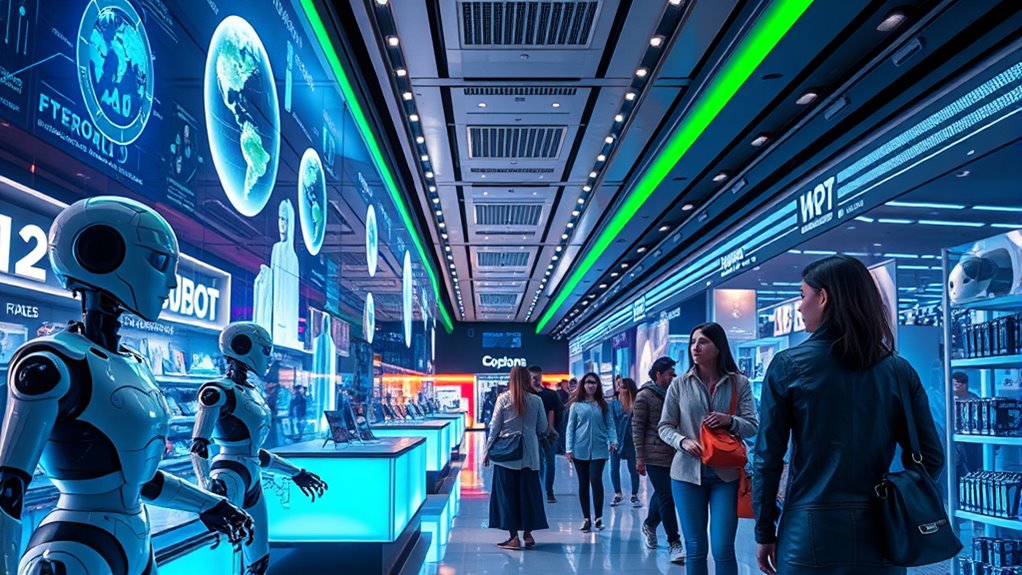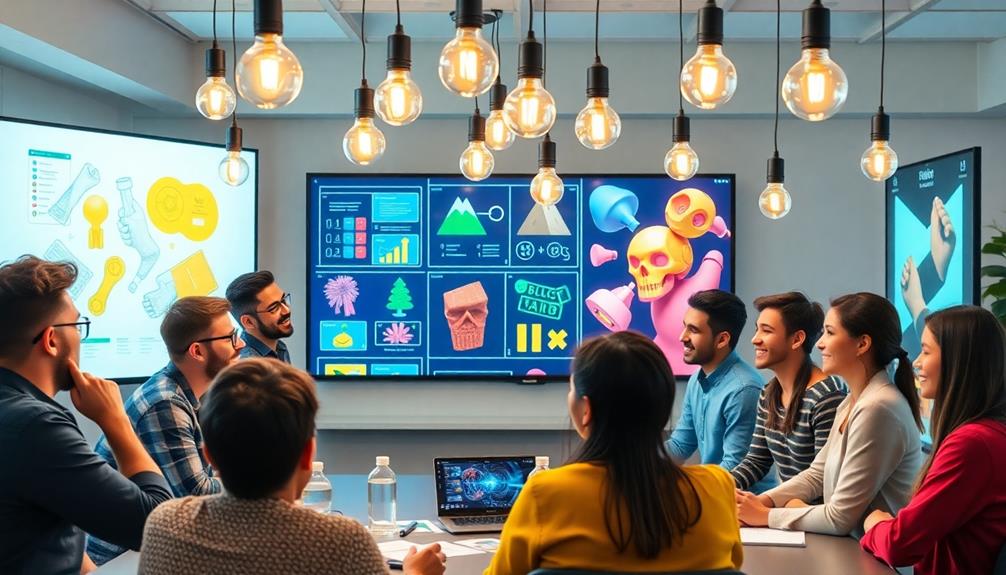By 2030, retail will become a global, AI-driven economy that offers highly personalized shopping experiences tailored to your preferences and values. Advanced digital and physical environments will seamlessly blend, with virtual reality and immersive tech transforming how you shop. Stores will serve as entertainment and social hubs, while smart supply chains ensure products are available worldwide. To discover how these changes will impact you and the upcoming retail landscape, explore further.
Key Takeaways
- Retail in 2030 will be globally interconnected, driven by AI personalization and immersive virtual shopping experiences.
- AI algorithms will analyze consumer behavior to recommend products, optimize supply chains, and enable dynamic pricing.
- Physical stores will serve as experiential hubs, blending shopping, entertainment, and social interactions within urban environments.
- Consumer diversity and sustainability values will shape product offerings, emphasizing ethical practices and tailored experiences.
- Digital and physical retail will seamlessly merge through advanced logistics, AR/VR technologies, and mobile omnichannel strategies.

By 2030, retail will be transformed into a truly global, AI-driven economy where personalization, seamless integration, and consumer diversity reshape how you shop. You’ll notice that shopping isn’t just about choosing products anymore; it’s about experiences tailored precisely to your preferences, habits, and values. AI algorithms will analyze your behavior, recommend products, and even anticipate your needs before you realize them, making every shopping encounter uniquely yours. Virtual and augmented reality will create immersive environments, allowing you to explore products in “new retail worlds” from your living room, merging digital interactions with physical sensations. As populations age, the demand for health, convenience, and accessibility services will grow, especially among Baby Boomers. You might find more retail spaces designed for easier access, with services catering to your well-being. Meanwhile, Generation Z—digital natives—will shape retail with their preference for digital, ethical, and personalized experiences. Their expectations will push retailers to prioritize transparency, sustainability, and social responsibility, aligning with their values. Urbanization will continue to intensify, ensuring brick-and-mortar stores remain crucial hubs within city centers and neighborhoods, even as online shopping surges. These physical stores will serve as experience centers, blending shopping, entertainment, and social interaction into integrated environments. Consumer diversity will be more prominent than ever. Retailers will need to offer tailored products and services that reflect various ethnic, cultural, and age-specific needs. This diversity will drive innovation and expand consumption patterns across the globe. Simultaneously, economic growth in emerging markets will nearly triple middle-class spending by 2030, fueling retail expansion outside Western regions. Urbanization and rising disposable incomes will sustain this growth, even as geopolitical tensions introduce supply chain uncertainties, affecting product availability and prices. Global population growth will increase the demand for retail goods and services worldwide, further accelerating the evolution of retail landscapes. Technology will be at the core of this transformation. AI will optimize supply chains, enable dynamic pricing, and facilitate seamless logistics. Mobile devices—used by over 75% of the global population—will be essential for omnichannel strategies, connecting physical and digital retail effortlessly. While 3D printing remains uncertain at a mass scale, it could revolutionize inventory management and customization. As AI-driven systems become more sophisticated, they will help retailers better understand and cater to consumer preferences, fostering deeper engagement and loyalty. Overall, retail in 2030 will be a complex, interconnected ecosystem, where consumer preferences, technological advances, and global shifts combine to redefine how you shop every day.
Frequently Asked Questions
How Will Small Retailers Adapt to Ai-Driven Global Markets?
To adapt to AI-driven global markets, you should focus on implementing scalable AI solutions that integrate seamlessly with your existing systems. Invest in workforce training to maximize AI benefits, leverage AI for personalized marketing, and collaborate with vendors to stay updated on regulations. By embracing data-driven decision-making, you’ll respond faster to supply chain disruptions and shifting customer demands, ensuring your small retail business remains competitive and resilient in this evolving landscape.
What Are the Privacy Concerns in a Highly Connected Retail Economy?
You should be aware that privacy concerns in a highly connected retail economy include potential data breaches, unauthorized AI data collection, and opaque profiling methods. Consumers demand transparency and control over their information, so you need clear communication and robust security measures. Failing to comply with regulations like GDPR and CCPA risks lawsuits and reputational damage. Proactively managing data privacy and securing consumer trust are essential for your success.
How Will AI Impact Employment in the Retail Sector?
AI will shake up retail employment like a storm on the horizon. You’ll see routine roles, like cashiers and stockers, shrink as automation takes over. Meanwhile, new jobs in AI, data analysis, and supply chain management will emerge, offering high-paying opportunities for those upskilling. However, many workers may face displacement, especially in low- and middle-skill roles, making the job landscape more competitive and demanding adaptation.
What Role Will Emerging Markets Play in 2030’s Retail Landscape?
By 2030, emerging markets will become the heart of the retail landscape, driving growth through rising middle classes and urbanization. You’ll see rapid adoption of AI, mobile-first shopping, and innovative logistics, allowing local retailers to compete globally. Consumer preferences for personalization, sustainability, and convenience will shape product offerings. Your focus should be on leveraging digital infrastructure, customizing strategies for regional markets, and embracing supply chain innovations to capitalize on these dynamic opportunities.
How Can Consumers Ensure Data Security Amidst AI Integration?
To make certain your data security amid AI integration, you should stay informed about how companies handle your data, demand transparency, and read privacy policies carefully. Use strong, unique passwords, enable multi-factor authentication, and limit sharing personal information online. Support businesses that prioritize responsible data practices, and consider using personal security tools like encryption. Being proactive helps you protect your privacy and build trust in AI-driven services.
Conclusion
By 2030, you’ll see a world where AI seamlessly connects global markets, making shopping smarter and more personalized than ever. It’s like having a futuristic crystal ball that predicts your needs before you even know them. This AI-driven economy will break down borders, creating a truly interconnected retail universe. Just remember, even in this sci-fi future, staying adaptable is key—because, unlike your vintage vinyl, retail won’t stay the same for long.










